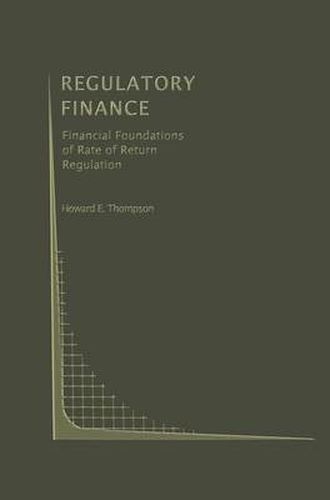Readings Newsletter
Become a Readings Member to make your shopping experience even easier.
Sign in or sign up for free!
You’re not far away from qualifying for FREE standard shipping within Australia
You’ve qualified for FREE standard shipping within Australia
The cart is loading…






This title is printed to order. This book may have been self-published. If so, we cannot guarantee the quality of the content. In the main most books will have gone through the editing process however some may not. We therefore suggest that you be aware of this before ordering this book. If in doubt check either the author or publisher’s details as we are unable to accept any returns unless they are faulty. Please contact us if you have any questions.
This monograph is concerned with the determination of the allowed rate ofreturn in rate cases which, in part, determines the rates ofcharge to customers of public utilities. Rate of return determination has been a central topic in utility regulation for a century. Recent changes in the traditionally regulated markets - electricity, gas, and telephone - have shoved discussion of rate of return determination into the background, replacing it by technology changes, competition, downsizing, deregulation, and reg'ulatory incentive systems. These new issues have made the regula tory sector, which had the reputation of being stodgy and uninteresting, an exciting field ofstudy. But rate ofreturn is not dead. It will playa key role in whatever the new structure ofthe regulated sector. Separating generation from transmis sion and distribution will not eliminate the need for rate of return analysis in the electric utility industry. Rather, it may well increase the number of companies for which the rate of return needs to be determined. It will playa fundamental role in the new regulatory environment. Incentive systems in the regulated sector may be the wave of the future but they will use the required rate ofreturn as a benchmark. Rate case will persist. Most rate cases include opposing testimony as to the fair rate of return or even the cost ofcapital for a public utility whose rates are at issue.
$9.00 standard shipping within Australia
FREE standard shipping within Australia for orders over $100.00
Express & International shipping calculated at checkout
This title is printed to order. This book may have been self-published. If so, we cannot guarantee the quality of the content. In the main most books will have gone through the editing process however some may not. We therefore suggest that you be aware of this before ordering this book. If in doubt check either the author or publisher’s details as we are unable to accept any returns unless they are faulty. Please contact us if you have any questions.
This monograph is concerned with the determination of the allowed rate ofreturn in rate cases which, in part, determines the rates ofcharge to customers of public utilities. Rate of return determination has been a central topic in utility regulation for a century. Recent changes in the traditionally regulated markets - electricity, gas, and telephone - have shoved discussion of rate of return determination into the background, replacing it by technology changes, competition, downsizing, deregulation, and reg'ulatory incentive systems. These new issues have made the regula tory sector, which had the reputation of being stodgy and uninteresting, an exciting field ofstudy. But rate ofreturn is not dead. It will playa key role in whatever the new structure ofthe regulated sector. Separating generation from transmis sion and distribution will not eliminate the need for rate of return analysis in the electric utility industry. Rather, it may well increase the number of companies for which the rate of return needs to be determined. It will playa fundamental role in the new regulatory environment. Incentive systems in the regulated sector may be the wave of the future but they will use the required rate ofreturn as a benchmark. Rate case will persist. Most rate cases include opposing testimony as to the fair rate of return or even the cost ofcapital for a public utility whose rates are at issue.